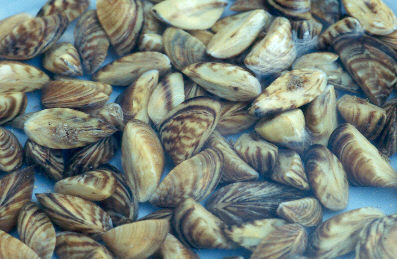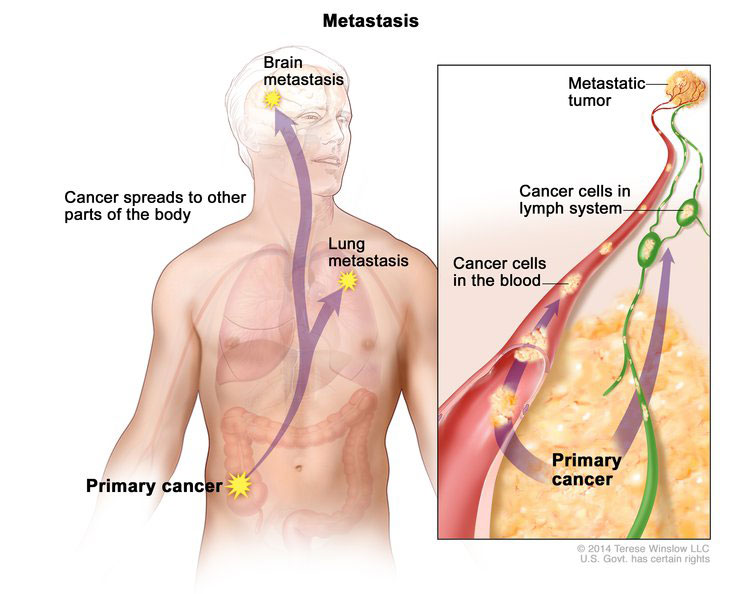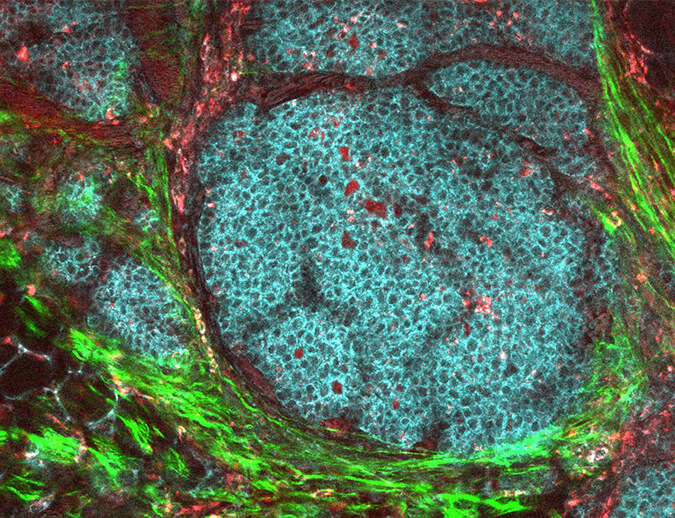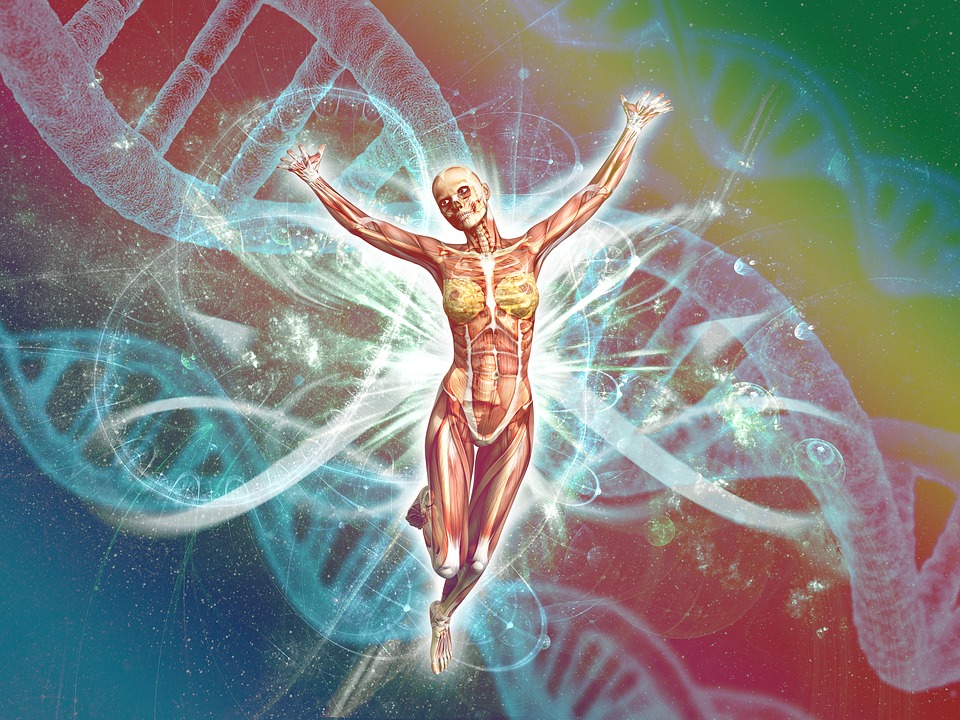Invasion
An invasive species is an organism which has been introduced to a non-indigenous ecosystem, where it flourishes without natural restrictions on its population. Many parallels can be drawn between the dynamics of an invasive species in a new environment, and that of cancer spread in the body. Just like an invasive species, a cell with tumorous potential in a setting without natural regulators will rapidly grow and spread, leaving a disaster in its wake. One well known example of an invasive species is the Zebra Mussel, introduced to the Great Lakes in the late 1980s from Europe. The Zebra Mussel’s ability to produce up to 500,000 eggs a year resulted in a population explosion. In a very short time, the mussels consumed much of the lakes’ native plankton upsetting the natural ecosystem, and encrusted boats and equipment causing billions in damage. If these creatures can wreak such havoc here, why don’t they cause the same problems in their native homes?

Zebra Mussels
Picture Credits: Amy Benson – U.S. Geological Survey
Public Domain
Like Zebra Mussels, our cells too have great potential for invasiveness. There are approximately ten trillion cells in the human body constantly being exposed to mutation inducing radiation and oxidative stress. With so many mutations undoubtedly occurring, the likelihood that oncogenes, tumor suppressors, and cell cycle regulators being affected and leading to tumor formation is so high that it is a wonder we don’t get more cancer. Indeed, many cancers may go unnoticed. Autopsies of patients who died from unrelated causes have revealed that 34% of men in their forties had small, early stage prostate carcinomas and 39% of women in their forties had early stage breast carcinomas. Given that actual diagnoses of prostate and breast cancers are much lower than this, the majority of these small carcinomas must never progress past the earliest stages. Why not? What is holding them back?
Environmental Regulation
Such Zebra Mussel population explosions as seen in North America do not occur in their native homes as mussels are limited by disease, space, and water quality, making them a relatively docile species. Similarly, the body’s tissue microenvironment (which includes neighboring cells and the extracellular matrix) normally acts to keep cells behaving as they should and suppress tumor growth. For example, myoepithelial cells in breast tissue secrete signal molecules which suppress invasion and metastasis of the luminal epithelial cells. Another example would be the death receptor ligands secreted by neighboring cells in many tissues to bind a diseased cell’s death receptors, triggering the caspase cascade and apoptosis. Normally these and other environmental factors keep invasive cells at bay, however, problems start to arise when the environment changes or an invasive cell from one tissue finds its way to another tissue without suitable regulators.
In the late 1800s Stephen Paget proposed the “seed and soil” hypothesis that cancerous cells were the seeds which require a suitable soil in the body to grow and metastasize. He proposed this after reviewing 735 autopsy records of patients who had died of breast cancer and noticing that certain sites of metastasis were highly favoured over others, namely, the liver, lungs, and specific bones. Metastasis occurs when cancer cells from the primary or initial tumour are transported in the lymph or blood to an organ where they form a secondary tumour.

Metastatic cancer
Originally published by the National Cancer Institute
Public Domain
The seed and soil theory is now widely accepted and there have been many supporting observations, in particular, studies have found that tumour cells injected into the bloodstreams of animals give rise to many fewer metastases than expected and only in certain organs. Of the organs most commonly affected, some consistently (ie. the liver) have larger and more numerous tumours than others, additionally, certain sites within organs are disproportionately colonized by tumorous cells. So, we know that for cancer to occur and progress in the body two things must occur:
1. There must be a mutagen to create a cancerous cell or ‘invasive species’
2. There must be a favourable environment in the body for the invasive species to thrive
So what makes a favourable environment? This question has yet to be fully answered though we do have an idea about some of the main players involved and how their interactions influence cancer. The tissue environment can be broadly referred to as stroma, which covers everything from extracellular matrix to vasculature to immune cells.

Breast cancer tumor and its microenvironment
Credit: National Cancer Institute \ Carbone Cancer Center at the Univ. of Wisconsin
Originally published by the National Cancer Institute
Public Domain
It is the inflammatory responses and interactions in the stroma which is thought to be one of the main determinants in cancer progression. Chronic inflammation can lead to fibrosis (over-deposition of collagens and other extracellular matrix proteins in the stroma) which is correlated with liver, breast, and lung cancer. Immune cells are recruited to sites of inflammation and play many roles in cancer initiation and growth; macrophages in particular, promote the invasion and migration of breast cancer by releasing growth factors to stimulate tumor proliferation, and proteases to break down stromal proteins and clear a path for cancerous cells. Inflammation also results in angiogenesis, the creation of new blood vessels which provide the ready supply of nutrients required by cancerous cells.
Control
Now let’s jump back to Zebra Mussels and other invasive species, how do we get rid of them? Pesticide and other chemical eradication is attempted against many species, such as New Zealand’s rodents, however these are costly, dangerous to native species, and largely ineffective. Sometimes success is achieved through biocontrol: the introduction of natural predators or pests to reduce negative impacts of invasive species. Biocontrol alters the ecological environment to restore balance. Given that we most likely cannot stop cancer-causing mutations from happening, perhaps a similar approach to control is necessary. Treatments to regulate and restore balance to the tumour environment may be the key to managing these invasive organisms.


Recent Comments